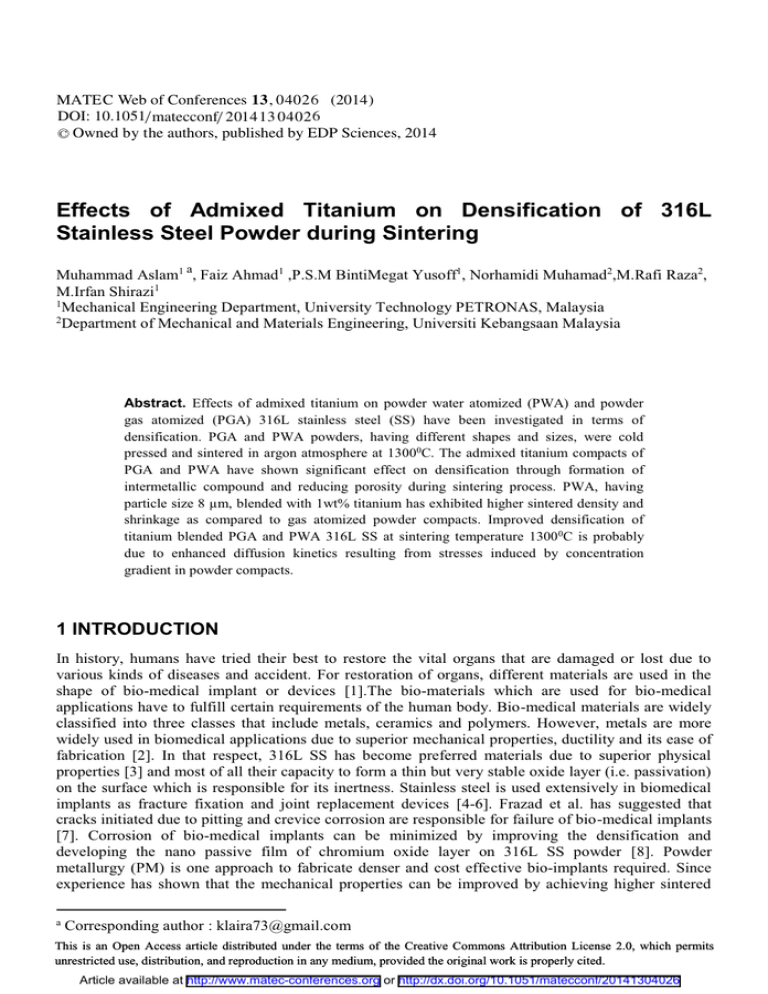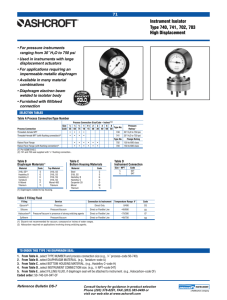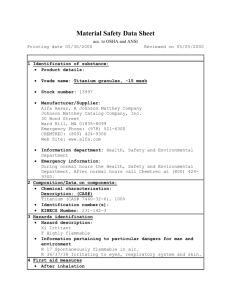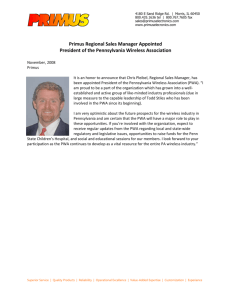, 0402 (2014) Web of Conferences MATEC
advertisement

MATEC Web of Conferences 13 , 0402 6 (2014) DOI: 10.1051/matecconf/ 201 4 13 0402 6 C Owned by the authors, published by EDP Sciences, 2014 Effects of Admixed Titanium on Densification of 316L Stainless Steel Powder during Sintering Muhammad Aslam1 a, Faiz Ahmad1 ,P.S.M BintiMegat Yusoff1, Norhamidi Muhamad2,M.Rafi Raza2, M.Irfan Shirazi1 1 Mechanical Engineering Department, University Technology PETRONAS, Malaysia 2 Department of Mechanical and Materials Engineering, Universiti Kebangsaan Malaysia Abstract. Effects of admixed titanium on powder water atomized (PWA) and powder gas atomized (PGA) 316L stainless steel (SS) have been investigated in terms of densification. PGA and PWA powders, having different shapes and sizes, were cold pressed and sintered in argon atmosphere at 13000C. The admixed titanium compacts of PGA and PWA have shown significant effect on densification through formation of intermetallic compound and reducing porosity during sintering process. PWA, having particle size 8 µm, blended with 1wt% titanium has exhibited higher sintered density and shrinkage as compared to gas atomized powder compacts. Improved densification of titanium blended PGA and PWA 316L SS at sintering temperature 13000C is probably due to enhanced diffusion kinetics resulting from stresses induced by concentration gradient in powder compacts. 1 INTRODUCTION In history, humans have tried their best to restore the vital organs that are damaged or lost due to various kinds of diseases and accident. For restoration of organs, different materials are used in the shape of bio-medical implant or devices [1].The bio-materials which are used for bio-medical applications have to fulfill certain requirements of the human body. Bio-medical materials are widely classified into three classes that include metals, ceramics and polymers. However, metals are more widely used in biomedical applications due to superior mechanical properties, ductility and its ease of fabrication [2]. In that respect, 316L SS has become preferred materials due to superior physical properties [3] and most of all their capacity to form a thin but very stable oxide layer (i.e. passivation) on the surface which is responsible for its inertness. Stainless steel is used extensively in biomedical implants as fracture fixation and joint replacement devices [4-6]. Frazad et al. has suggested that cracks initiated due to pitting and crevice corrosion are responsible for failure of bio-medical implants [7]. Corrosion of bio-medical implants can be minimized by improving the densification and developing the nano passive film of chromium oxide layer on 316L SS powder [8]. Powder metallurgy (PM) is one approach to fabricate denser and cost effective bio-implants required. Since experience has shown that the mechanical properties can be improved by achieving higher sintered a Corresponding author : klaira73@gmail.com This is an Open Access article distributed under the terms of the Creative Commons Attribution License 2.0, which permits unrestricted use, distribution, and reproduction in any medium, provided the original work is properly cited. Article available at http://www.matec-conferences.org or http://dx.doi.org/10.1051/matecconf/20141304026 MATEC Web of Conferences densities in PM parts, it is necessary to find efficient methods to increase the sintered density. An approach to achieve higher sintered density is to use blended powders, either elemental or their combinations using a master alloy with CP Ti (Commercial Pure Titanium that can achieve up to 99 % sintered density [9-11]. This approach allows one to use the most cost-effective PM process for 316L SS alloys which is cold pressing and sintering, and it can achieve higher sintered densities at higher sintering temperature. In current research work, titanium influence on sintering behavior of 316L SS powder of different shapes and sizes was determined through scientific explanation of enhanced densification of blended alloy. 2 Raw materials and experimental procedures Powder water atomized was manufactured and supplied by Sowa Pacific, Japan. Powder gas atomized was supplied by ZheJiang BaiNianYin Industry & Trade CO.LTD China. Titanium powder was provided by Luoyang Zhongbo Rare Metal Material Co. Ltd, China. Chemical composition of both PWA and PGA 316L SS, as provided by the suppliers, are given in Table 1 Table 1: Chemical composition of PGA and PWA 316L SS PGA PWA Elements wt% Elements Wt% C < .08 C 0.024 Si <1 Si 0.36 Mn <2 Mn 0.07 P P 0.029 S S 0.002 Ni 10-14 Ni 10.53 Cr 16-18 Cr 16.57 Mo 2-3 Mo 2.1 Cu Cu 0.1 2.1 Green samples and Sintering Titanium powder 1wt% was blended with PGA and PWA at 50 rpm in ball mill for 30 minutes. The ingredients were blended in ball mill without addition of additives. Various formulations that were used in this study are listed in Table 2. Titanium admixed 316L SS powder blends were compacted in a circular die of diameter 13 mm and green samples with size Ø13 mm x 8.25 mm were produced using compressing machine at ambient temperature followed by sintering at 1300 0C in argon atmosphere as shown in Figure 1. The sintering cycle used for producing circular shape samples is shown in Figure 2. (b) (a) Figure 1.PGA and PWA 316L SS (a) Green samples (b) Sintered samples with silvery metallic appearance Table 2.Composition of 316L SS formulations SNo. Formulations 1 PGA 316L SS (wt%) 100 Titanium (wt%) - 2 PGA-Ti1-1300 99 1 3 PWA 100 - 4 PWA-Ti1-1300 99 1 Figure 2.Sintering cycle for 316L SS 04026-p.2 ICPER -2014 2.2 Characterization Techniques Average particle sizes of PGA, PWA and titanium powders were measured 27 μm, 8 μm and 20 μm respectively by using particle size analyzer MASTERSIZER 2000. PGA, PWA and titanium powder particles morphologies were characterized using scanning electron microscope (SEM). PGA and titanium particles are in spherical shape and PWA powder particles are in irregular shape as shown in Figure 3. Green densities of samples were calculated by mass-volume measurement. However, sintered densities were measured using water immersion technique. For microscopic examination, samples were etched by using etchant 87-Glyceregia to reveal the microstructure and were examined under optical microscope (OM). Volume shrinkage of samples was calculated by measuring the volume change of green and sintered samples. (a) (b) (c) Figure 3.Powder morphology of (a) PGA 316L SS (b) PWA 316L SS (c) Titanium powder 3 Results and discussions 3.1 Comparison of Sintered Densities Sintered densities of powder gas atomized, powder water atomized and blends of both types of 316L SS powder with titanium powder were measured by water immersion technique. Theoretical densities of PGA-Ti1-1300 and PWA-Ti1-1300 were calculated by rule of mixture. A comparison study of sintered densities for four formulations is shown in Figure 4. It is clear from Figure 4, the densities of PGA-Ti1-1300 and PWA-Ti1-1300 formulation are higher than PGA-1300 and PWA-1300 respectively. It has been already established that densification of austenitic stainless steel proceeds via lattice or volume diffusion during the initial and intermediate stage of sintering [12, 13]. During sintering of PGA-Ti1-1300 and PWA-Ti1-1300, diffusion paths and kinetics are considered the main reasons for increasing the sintering rate at temperature 1300 0C. The formation of intermetallic compounds between titanium and 316L SS is associated with strong exothermic enthalpies of mixing. Such local adiabatic heating released from formation of new compounds have contributed positively in improving the densification. However, this phenomenon is absent in PGA and PWA 316L SS. After sintering, silvery metallic appearance of outer surface of sintered samples reflects the presence of chromium layer as shown in Figure 1. Relavent density,% Figure 4.Sintered densities of 316L SS formulations 04026-p.3 MATEC Web of Conferences 3.2 Effect of titanium addition on porosity and shrinkage of 316L SS During sintering, lattice and surface diffusion play an important role in high densification Thus, pore migration occurs by a combination of both surface and lattice diffusion process. Optical micrographs suggest that large pores act as vacancy sinks and pin the grain boundary, while small pores separate from the grain boundary and exhibit Ostwald ripening type behavior [14] as shown in Figure 5. It can be seen in Figure 5, titanium addition in PGA coarsen the pores on grain boundaries by sinking trapped small pores and eventually improve densification process. In case of water atomized powder, the amount of porosity is less as compared to PGA and titanium addition in PWA has assisted in migrating porosity from center of grains to boundaries. In addition, increase in pore size is observed concomitant with a reduction in porosity. By comparing the magnitude of porosity between PGA and PWA, it has been observed that powders of smaller particle size i.e PWA have narrower inter-particle spaces and promote high densification even at lower temperature and compression force as compared to PGA. This observation is in agreement with Okubo et al research work[15]. Moreover, some stains are observed in OM micrograph due to bleeding of etchant as shown in Figure 5(b), (c) and (d). Figure 6 shows the higher rate of shrinkage in titanium-blended 316L SS as compared to non-blended compacts because of faster annihilation of porosity. (a) (c) (b) (d) Figure 5.OM micrographs of (a) PGA 316L SS (b) PGA-Ti1-1300 (c) PWA-1300 316L SS (d) PWA-Ti1-1300 Figure 6.Shrinkage rate of 316L SS formulations 04026-p.4 ICPER -2014 4 Conclusions The sintering behavior of titanium blended 316LSS powder compacts was studied and following conclusions were reached. (1) 1 wt % titanium blended PWA 316L SS compact i.e PWA-Ti1-1300, exhibits higher sintering rate which results 3% high densification than PGA-1300 at 13000C. (2) Sintering temperature for PGA blended alloys seems to be higher than 1300 0C for achieving high densification. (3) The formation of intermetallic compounds of admixed titanium with PGA and PWA 316L SS is associated with strong exothermic enthalpies of mixing and such local released adiabatic heating assists in improving the densification process. (4) Shrinkage rate of PWA-Ti1-1300 is approximately 2.5% higher than PWA at 1300 0C. (5) Titanium blended 316L SS compacts can attain the high density if PM process variable are optimized. (6) Sintering mechanism in the Ti-blended powder system has important implications for the design of other powder blended systems that can lead to enhanced sintering through the incorporation of phase changes and compound formation. Acknowledgement Authors are thankful to University Technology PETRONAS for providing fund for this research. References 1. 2. 3. 4. 5. 6. 7. 8. 9. 10. 11. 12. 13. 14. 15. B. D. Ratner, et al., Biomaterials science: an introduction to materials in medicine: Academic press, (2004) S. V. Bhat, Biomaterials. Harrow, U.K.: Alpha Science International Ltd., (2007) A. Mahapatro, "Metals for Biomedical Applications and Devices," Journal of Biomaterials and Tissue Engineering, vol. 2, pp. 259-268, (2012) M. Sumita, "Present status and future trend of metallic materials used in orthopedics," Seikeigeka, vol. 48, pp. 927-934, (1997) D. E. Waite, "Overview and historical perspective of oral reconstructive surgery," Oral Surgery, Oral Medicine, Oral Pathology, vol. 68, pp. 495-498, (1989) S. Koul and D. J. Moliterno, "Bare-Metal Versus Drug-Eluting Stent Placement Among Patients Presenting With Anemia ," JACC: Cardiovascular Interventions, vol. 2, pp. 337-338, (2009) H. Amel-Farzad, et al., "In-body corrosion fatigue failure of a stainless steel orthopaedic implant with a rare collection of different damage mechanisms," Engineering Failure Analysis, vol. 14, pp. 1205-1217, (2007) H. Hermawan, et al., "Metals for biomedical applications," (2011) N. P. Xu X, Yan Y, Zwitter T, Int Conf Powder Metall Part Mater Metal Powder Ind Fed 7:137, (2011) G. A. Ahmed M, Savvakin DG, Ivasishin OM, Elena VP, J Mater Sci, vol. 47, (2012) X. X. Zwitter T, Nash P Proc Int Conf Powder Metall Part Mater Metal Powder Ind Fed 7:169, (2009) R. M. German, Metallurgical Transactions A, vol. 7A, pp. 1879-1885, (1976) J. K. T. Pieczonka, A. Tizani, and A. Molinari, Journal of Materials Processing Technology, vol. 64, pp. 327-334, (1997) M.-K. Kang, et al., "Ostwald ripening kinetics of angular grains dispersed in a liquid phase by two-dimensional nucleation and abnormal grain growth," Journal of the European Ceramic Society, vol. 22, pp. 603-612, (2002) S. T. K. Okubo, and H. Ito: Microsyst. Technol., 2010, and p. vol. 16 (12), Microsyst. Technol, vol. 16, pp. 2037-41,(2010) 04026-p.5





